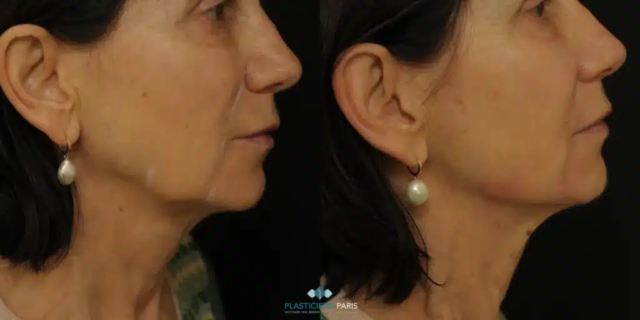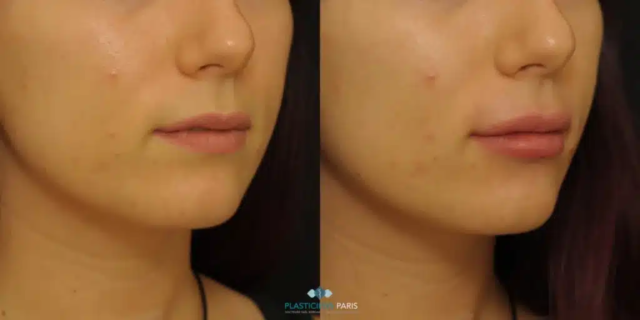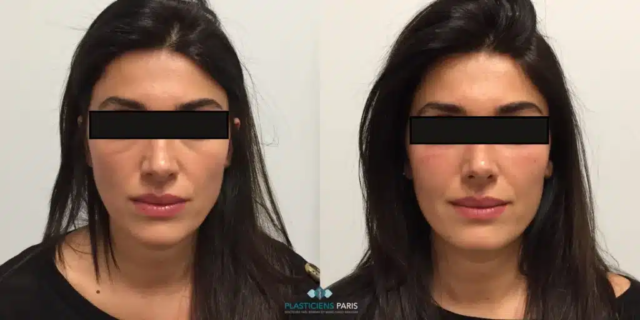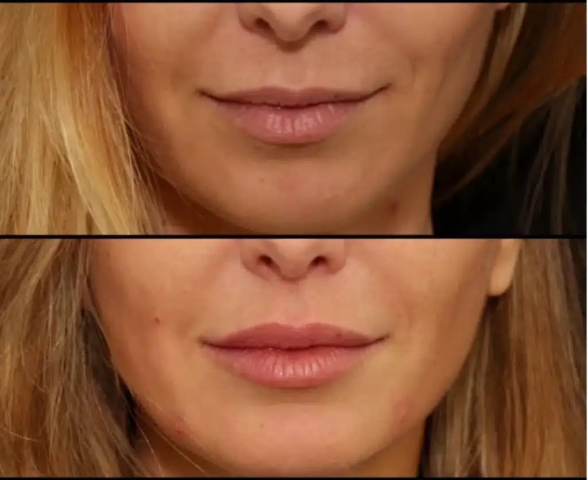Hyaluronic acid facial filler injection: Price, Before and After and procedure
Principles of hyaluronic acid filling injections
Injection of fillers. This is a class of injectable medical devices designed to reduce wrinkles and/or modify facial volumes.
Hyaluronic acid is a resorbable compound naturally present in the skin, whose presence diminishes with age. It is currently the most widely used product, as it is easy to handle and has excellent tolerability. We most often use the Allegarn® and Galderma brands. They last between 6 and 12 months.
Hyaluronic acid injections for the face: areas treated and practical procedure (frown lines, furrows, lip volume...)
The most frequently made corrections are:
- Folds: nasolabial folds, bitterness folds (from the corner of the mouth)
Wrinkles and fine lines: frown lines, crow's feet, cheeks, around the mouth
Areas that may lack volume: lips, cheekbones, chin, cheeks, tear trough, temples.
An injection session can be performed alone, but can also complement medical rejuvenation techniques such as peels and botulinum toxin injections.
Before facial hyaluronic acid injections
Emla® cream can be applied one hour before the injection, on the areas to be treated. It helps to reduce the painful sensations on the surface.
Procedure for facial hyaluronic acid injection
The treatment will be carried out in the office. Depending on the number of areas to be treated and the extent of the improvements required, the injection session can last from 10 to 30 minutes.
After facial hyaluronic acid injection
For the first six hours following the injection, it is best to remain calm, rest and refrain from any violent effort. The immediate aftermath may be marked by the appearance of edema and skin redness, the extent and duration of which vary greatly from one individual to another, but which usually remain very moderate and disappear after one to three days.
It is strongly recommended not to perform treatments 15 days following the injection.
More information on hyaluronic acid filling injections
What are the side effects of hyaluronic acid injections?
It should be noted that the first few days, there may be some temporary irregularities due to the inhomogeneous distribution of the edema, or an aspect of hypercorrection (in relief) which will gradually disappear.
A number of reactions can also be observed:
Local post-injection reactions: oedema, redness, pallor, irregularities, sensitivity, itching, ecchymosis. These reactions are temporary.
Outbreak of cold sores: in susceptible individuals.
Acute or chronic inflammatory reaction: possible after secondary injection in an area that has already been injected with other products, especially non-absorbable products.
However, you should be wary of filling injections (including resorbable hyaluronic acid) in the hollow of dark circles.
This is because the product can diffuse into the fat of the orbit, an anatomical zone that is highly sensitive to inflammation.
Cases of chronic, difficult-to-treat peri-ocular inflammation have been described.
We prefer to propose surgical treatment for this area.
Granulomas: These are small, indurated nodules, more or less sensitive, perceptible to the touch, sometimes visible and unsightly. They correspond to a localized inflammatory reaction that may evolve in flare-ups. They may appear a few days to a few weeks after the injection. These granulomas are in fact extremely rare with resorbable products, and are spontaneously regressive.
Nevertheless, if they prove troublesome, an injection of the enzyme hyaluronidase is possible to dissolve the injected hyaluronic acid.Outbreak of cold sores: in susceptible individuals.
Acute or chronic inflammatory reaction: possible after secondary injection in an area that has already been injected with other products, especially non-absorbable products.
Can hyaluronic acid injections be repeated to fill wrinkles?
Yes, but you should not overuse them. Indeed, although the products are resorbable and of natural origin, they contain chemical stabilizers (BDDE) that can create local inflammation. Uncontrolled repetition of filling injections with multiple practitioners can cause chronic inflammation of the face, giving a red and shiny appearance to the skin.
It's essential to keep a record of all injected products in a "beauty passport". It's also important to understand that these rejuvenation injections are aimed at the first signs of facial aging, often between the ages of 35 and 50. More serious alterations are best dealt with surgically, and it's important not to become addicted to injections.
Hyaluronic acid injections: how to avoid an unnatural look with fillers?
Too many procedures or too much volume can give a "duckbill" appearance to the upper lip or a "puffed" look to the cheekbones. It's best to limit yourself to the areas that really need filling, without trying to radically alter the volumes of the face.
How much does a hyaluronic acid injection into the nasolabial fold cost?
The price of a hyaluronic acid injection in the nasolabial folds starts at €450.
How much does a hyaluronic acid injection in the upper lip cost?
The price of a hyaluronic acid injection in the upper lip starts at €300.
Hyaluronic acid facial injections: Before and after photos
Take a look at the before-and-after results of facial hyaluronic acid injections performed by Dr Berdah and Dr Benjoar for over 15 years in Paris.
Have a question? Please contact us!
Cosmetic surgery in Paris
Docteur Yaël Berdah and Docteur Marc-David Benjoar
Plastic surgeons in Paris France




